Items
Subject is exactly
Museums & Libraries
-
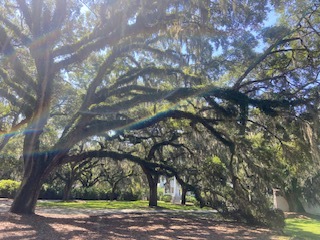 2023-07
2023-07Boston & Italy During Covid; Civil Rights Trip 2023
Prior to the world-stopping "Covid Times," my friends and I had planned to travel to Boston, MA. We were going to watch a Braves v. Red Sox game, visit Salem and the Freedom Trail in Boston. We had tickets, airfare, lodging etc. Then the world shut down. Because of life circumstances, we had to delay further after the world opened back up, and decided to shift gears and take a different trip. This would be a Civil Rights trip in the Summer of 2023. Again, life circumstances created the need to adjust. Two members of our group (half of us) were no longer able to travel, so myself and the other member of our group went. The trip was great. We flew into NC, then drove to Charleston where we spent a couple days. It was great because we were able to visit several places which were very impactful to both of us. McLeod Plantation was a wonderful & educational experience. We were given a fantastic guided tour where we learned much about the enslaved people who made the plantation function, and then about their descendants, some of whom lived there until the 1990's. We also visited the Old Slave Mart which was one of the most prominent sites in Charleston for slave sales. It has now been turned into a museum and memorial. From Charleston, we visited Savannah. We were only there about 12 hours, but were able to visit the house of a very prominent slave trader and see the living and working quarters of the people enslaved there. From there, we went to Atlanta (I got to watch a game at Truist Park!) for the night, and then on to Montgomery. If we could do it again, I would spend much more time in Montgomery. We visited the Legacy Museum which was, in a phrase, life changing. The experience was phenomenal and extremely visceral. I think it is something every American should experience at least once. We spent the whole day, and barely scratched the surface. And that was just the museum and monument. From Montgomery we drove to Selma and were able to walk the Edmund Pettus Bridge. We also drove around town a little and were able to see some of the churches, and neighborhood that were so influential in the Civil Rights Movement and the powerful Selma to Montgomery March. From there, we went to Memphis where we visited the National Civil Rights Museum. That was also a wonderful experience. This was such an awe-inspiring trip. It was very quick, but it was fantastic. It is a trip that I would take again though next time for longer. -
2020
Continuous Travels Throughout The Pandemic
As an Active Duty Soldier during the COVID-19 pandemic I was able to travel; albeit my movements were extremely controlled and job-related and not for leisure. On 13 March 2020, when the entire Country literally reacted to and shut down due to COVID-19, I was out of town and hours away from traveling back to my duty station. The sudden reality we were all faced with felt like The Twilight Zone, especially since it was also a Friday. In May of 2020, I drove to my hometown of San Antonio, TX. My mother was a COVID patient in the ICU, and I needed to get home to help take care of my father. Thankfully, my mother recovered, and I returned to Tennessee, where I was stationed at the time. The COVID restrictions from Tennessee and Texas could not have been more different; whereas Clarksville, Tennessee treated public separation and mask-wearing with a laissez-faire attitude, San Antonio was very strict with its public safety ordinances. A few months later, I deployed to Iraq; transiting to and from the Combat Zone was extremely restrictive. Prior to the Pandemic, we could enjoy local sightseeing if we had a layover in Spain or Germany; naturally, during COVID we were confined to our lodging. However, in January of 2021, as travel restrictions began to lift ever-so slightly, I participated in a unit training exercise in California. To my surprise, we had to fly commercially to Las Vegas, NV. To ensure 6-foot separation, we were each allowed our own rental vehicles, and our own hotel rooms while we trained in the California desert. In all my years in the military, that was the only time I wasn’t required to share a rental or hotel room with anyone. After we had concluded our training, we commuted back to Las Vegas. The original plan was to use military lodging on Nellis Air Force Base, however our Commander allowed us to find our own hotels in Las Vegas, as our flights would not depart for Nashville for another 36 hours or so. At that time of course, no one was traveling or booking rooms; I was able to find a room at the 4 Queens Casino on Fremont Street for forty dollars a night. This turned out to be far more cost-effective to the US Government, as we would have paid around ninety dollars a night had we stayed on Nellis AFB. Restaurants in Las Vegas during the Pandemic opened no earlier than noon, so we had a lot of time to kill in the morning. We walked up and down Fremont Street, the Strip, and it felt as though we were the only group of people in the city. Casinos were empty throughout the day and remained empty well into the night. Being thirsty Soldiers, we visited a Speakeasy and a couple of restaurants; again, with the eerie feeling like we were the only “tourists” there. We even visited the Mob Museum and enjoyed all the history and Prohibition artifacts at our leisure! Between multiple quarantines, working remotely, COVID tests, memorandums clearing us to leave the country, and the eventual vaccination, we continued military travel. It was impossible for my unit to cease all operations due to the Pandemic; we adjusted on the spot and continued to learn throughout the entire experience. It was impossible for me to narrow my travels during COVID to just one single memory; rather it felt like one continuous surreal dream. Today if anyone asks where or how I spent Lockdown, I have to ask, “When during the Pandemic are you referring to?” -
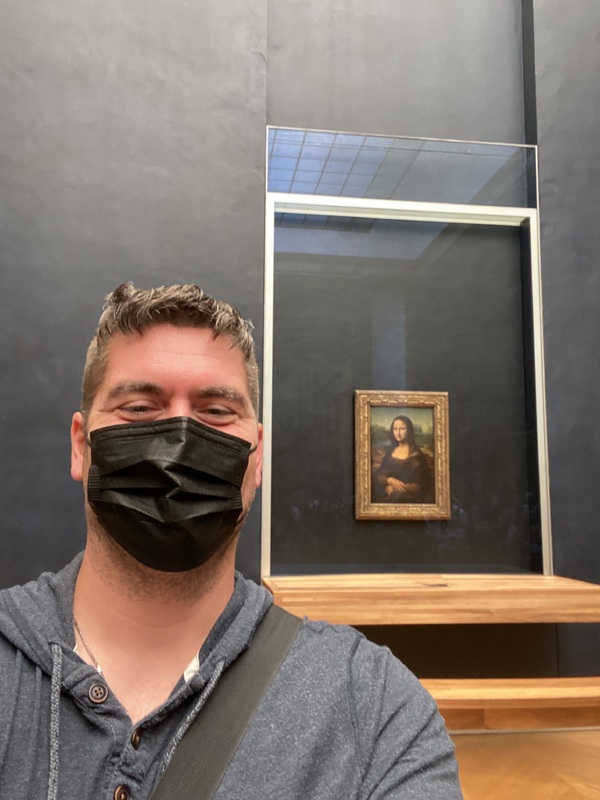 2022-06-03
2022-06-03First Student Trip After COVID-19 Pandemic Began
I have led a student global travel trip for the last 10 years at my school. Because of the COVID-19 outbreak in 2020, our trip to Australia and New Zealand was delayed/cancelled until 2021 in hopes of COVID being over by then. I had 27 students have to postpone traveling on this trip. In 2021, we came across the same restrictions, and our trip was cancelled again. As we we were planning our 2022 trip, New Zealand still had quarantine rules that would have kept us in the hotel for a week before we would get to go anywhere or do anything. Due to this, we changed our trip to one to France, Switzerland, Germany, and Austria. My students wanted to travel again, but did not know what to expect. There were still masking rules in place in a lot of the places we visited, and everyone had to take a mandatory COVID-19 test to be able to leave Europe at the end of the trip and get back into the United States. This was the scariest part because if your test revealed you were positive for COVID, you were required to stay in the country until you were negative. Everyone on the trip dreaded the day of the test because we had heard so many stories about other schools on different trips that had students who had failed the test. The trip was extremely important to me because it represented these students being able to fully restart their lives and finally be able to be kids again. This is a picture of me from the Louvre waiting my turn to see the Mona Lisa. It was taken immediately after I took a picture of all my students in front of the painting. I can see the happiness in my eyes again, getting to see students do something they love to do. -
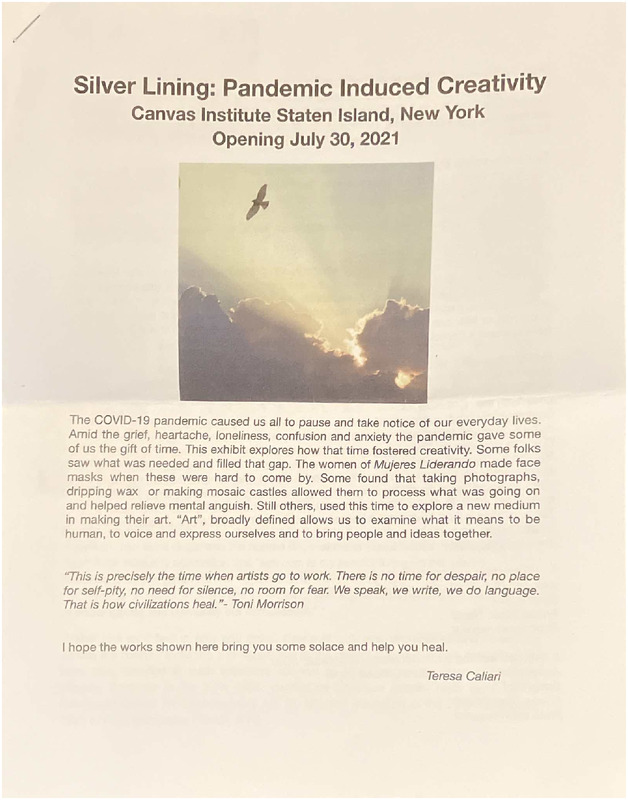 2021-07-30
2021-07-30Silver Lining- creativity brought on by the pandemic
I found myself doing “creative” things that I hadn’t had time for previously and so I asked Staten Island artists what they had created during the pandemic. For some it was a reaction to the politics of the time. For others it was an opportunity to try new media. -
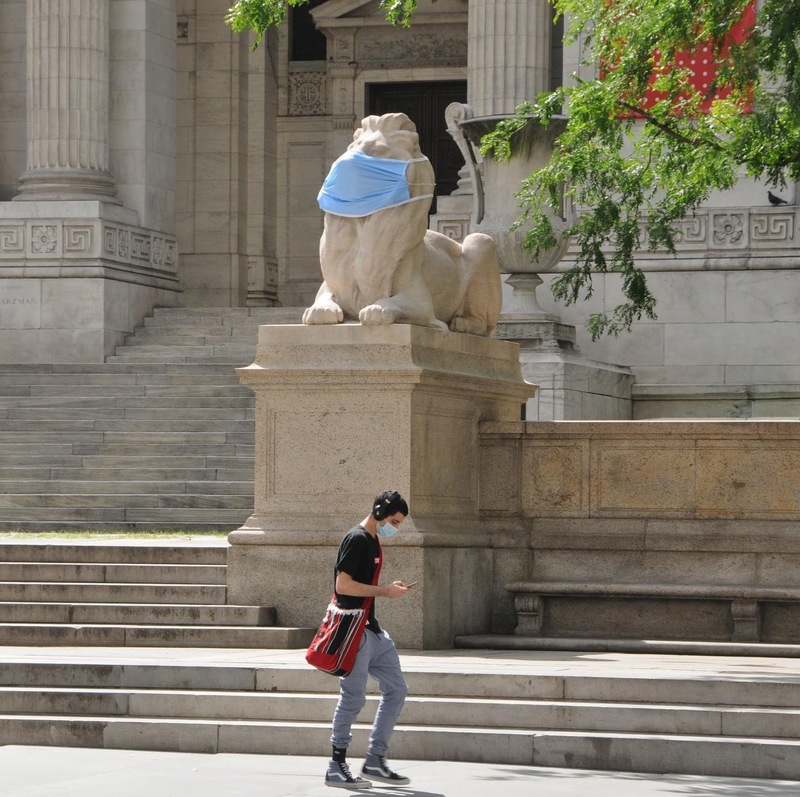 2020-07-27
2020-07-27Patience and Fortitude
The New York Public Library’s website explains, “During the 1930s, Mayor Fiorello LaGuardia named [the library lions] Patience and Fortitude for the qualities New Yorkers would need to survive the economic depression.” I remembered this fact and connected immediately with it the first time I saw Patience and Fortitude wearing their masks in solidarity with the New Yorkers they have watched over for more than a century. It struck me that we would need those virtues to make it through COVID-19 as well. “Those lion statues have seen New York struggle through and overcome many hardships from the 1917 Flu to the Great Depression to September 11th,” I thought. Things were grim in New York in 2020. We were the first to experience the horror that would eventually engulf the whole country. The infection rate was high, hospitals were full, people were dying. It was easy to despair. The masked lions were a powerful symbol of the resolve and resilience of New Yorkers and a reminder that this turmoil, too, would pass into history and the city - like the lions - would remain standing. -
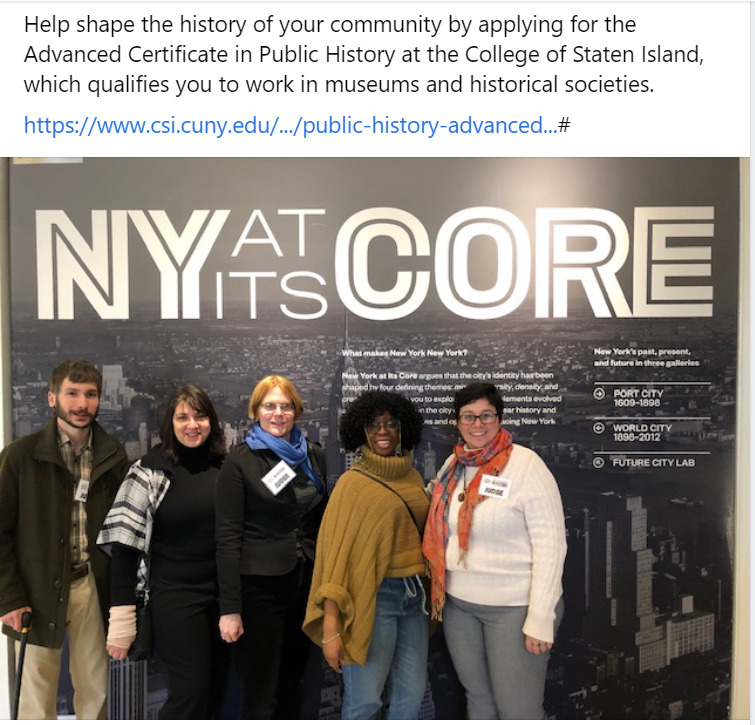 2020-06-17
2020-06-17NY at its Core
Help shape the history of your community by applying for the Advanced Certificate in Public History at the College of Staten Island, which qualifies you to work in museums and historical societies. -
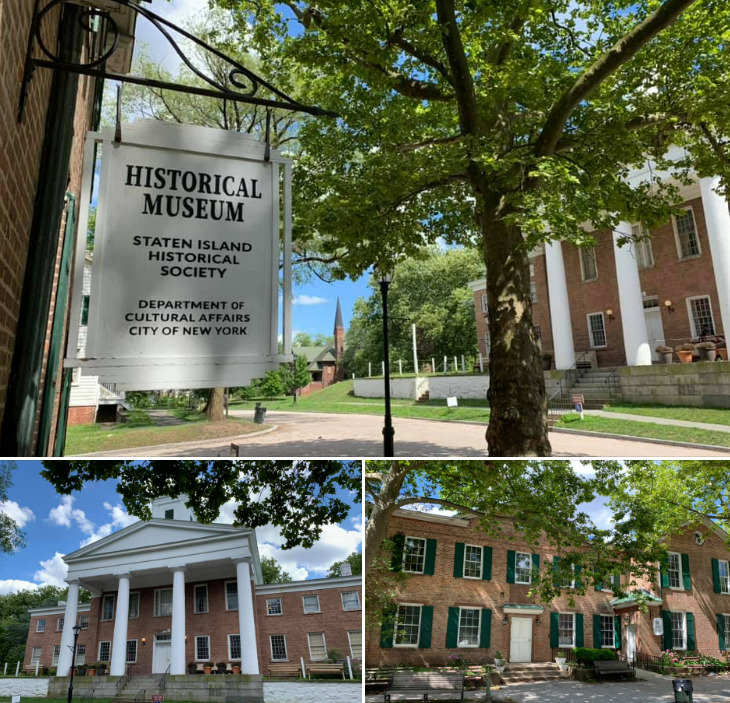 July 22, 2020
July 22, 2020A nice walk through Historic Richmond town.
A nice walk through Historic Richmond town. -
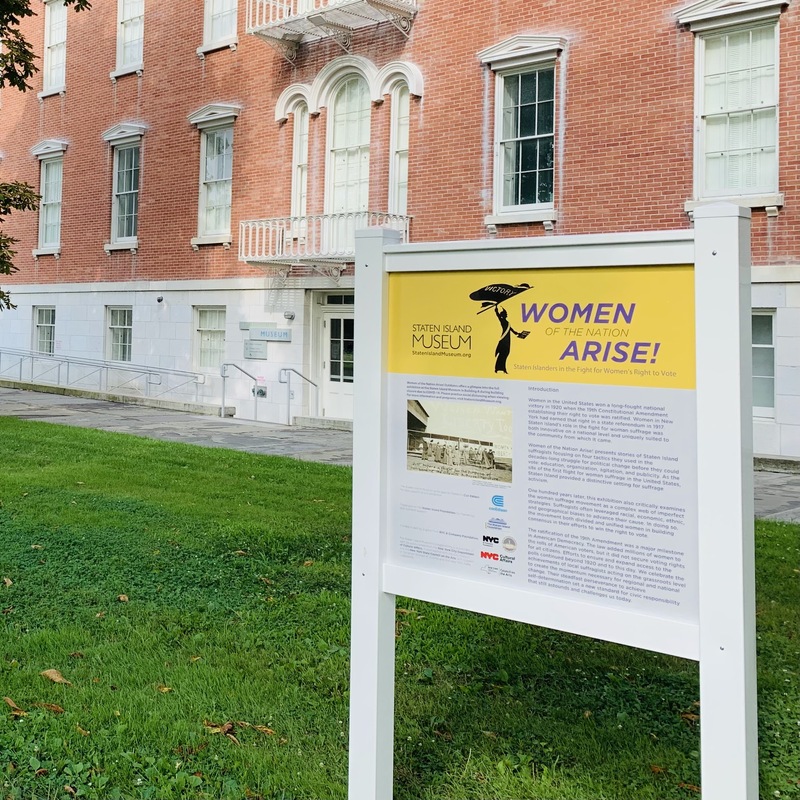 Summer 2020
Summer 2020Culture at a Social Distance
My submissions for #lockdownstatenisland are two examples of creative measures local cultural institutions implemented in Summer 2020 to continue to serve the public safely outdoors. The first is the #WomenoftheNationArise outdoor exhibition at the Staten Island Museum. The gallery exhibition opened a week before lockdown during Women’s History Month - March 2020. Since the galleries had to be closed, the outdoor exhibit gave visitors to Snug Harbor Cultural Center had the chance to explore Staten Island’s role in the fight for women’s right to vote from a #socialdistance. The second is at Historic Richmond Town’s socially distanced recreation area. With picnic tables and chalk circles on the grass, Historic Richmond Town provided a safe outdoor space to enjoy fresh air, sunshine, a book, an ice cream cone, and some time with friends or loved ones. -
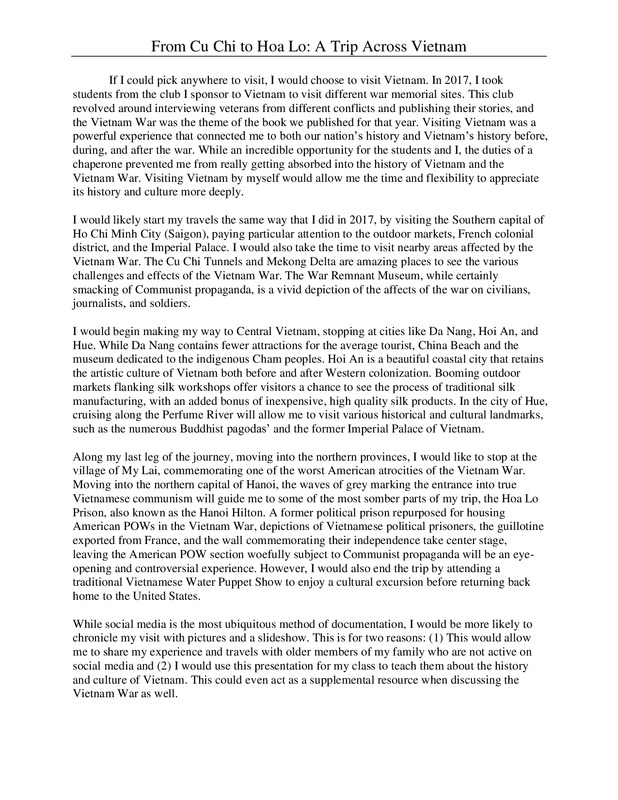 2018-03-11
2018-03-11From Cu Chi to Hoa Lo
Travel to Vietnam is seeing increased tourism in the post-COVID world, so while restrictions have dropped, certain destinations that have been included, such as the Cu Chi tunnels or the War Remnants Museum, which typically are densely packed, may have included changes to improve public safety and health. -
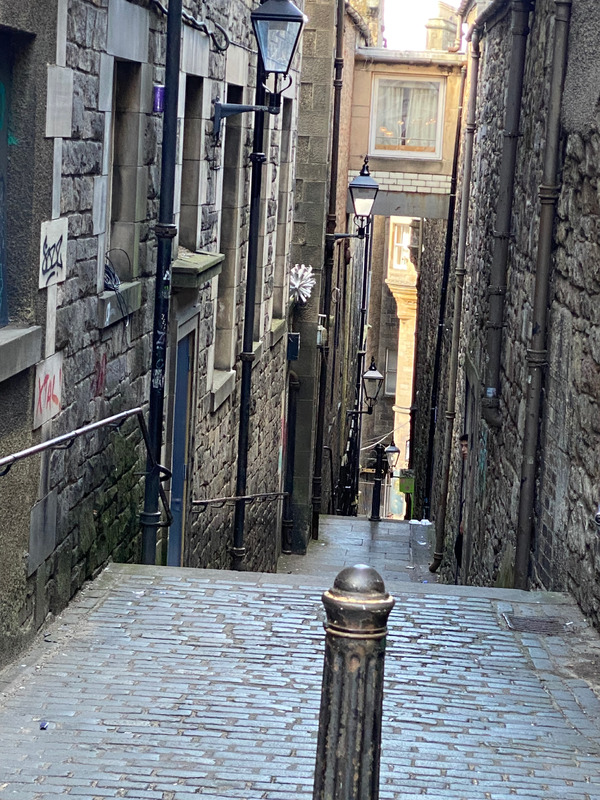 2021-04-18
2021-04-18Edinburgh and Northumberland, "Post Pandemic" Historical Tourism
I had been dreaming of this trip since 1996 when I went to England on a high school theatre and literature trip and fell in love with the UK. Specifically, I fell in love with Scotland and its history, becoming a British History enthusiast. In August, 2021, I completed my BA in History at ASU, then changed careers from Film/tv costuming to a special education teaching position. During the peak age of Covid-19, I worked full time, completed full time undergraduate studies, interned in politics and not-for-profit law, and started over in a new career and life in a new state. All of 2020-2021 was a non-stop adrenaline rush of constantly moving, getting Covid, and burning out mentally along the way. In 2021, I was halfway through a teaching contract and gravely unhappy, longing to just... escape. I kept dreaming of one photo of Edinburgh that was on my vision board. The picture, from Pinterest, was of a narrow Close in Old Town, Edinburgh, the historic "original" city that squeezed so much history and magic in about a mile. Old Edinburgh held tens of thousands of people in one square mile with their Closes serving as narrow alleyways between buildings of both stone and wood, both affluent and poor societal classes. After creating this vision board, I started working a ridiculous amount of overtime in the school's residences for special needs students and saving money. I was used to already working over 60 hours a week, so I didn't see the problem yet. The short staffing crisis of special education staff provided the opportunity to earn $40/ hour plus $1000 monthly bonus for anyone willing to work and be okay with less support for challenging behavior or emergency resources. I was willing to work hard to be free for just a short time over the Easter/Passover School break. Flight and accommodation prices were incredibly low at the start of 2021, encouraging tourists to travel. British Airways and other airlines offered incredible fares! These discounts still enabled me to book more affordable fare into 2023. My flight from Boston to Edinburgh was just over $400, with 7 nights stay in two 4 and 5 star hotels plus one castle for a total of less than $1000. My dream trip was planned to every detail and paid in advance or booked for free with historical memberships. The pandemic and rising popularity of Airbnb and Verbo created the perfect discounts for hotels and upgrades to better suites. Pre-pandemic, I got bed bugs from an Airbnb and had a nightmare of an experience, so it was out of the question for accomodation moving forward. While in planning stages, I booked historical tours and entry into sites like Edinburgh Castle, Mary Kings Close, Ghost Tours of the Vaults, Sterling Castle, then in England, Alnwick Castle and Chillingham Castle's paranormal investigation. I already had memberships to multiple British historical and public sites like the Alnwick Gardens (site of the famous Poison Garden) and Historical Scotland. From Edinburgh Castle to Chillingham Castle, I finally got to see the gallows, dungeons, and artifacts that were in my undergraduate classes. Finances and waiting for a travel companion to finally find "the time" to go held me back from going previously, but I was there, alone, at this particular time for a reason. I got to hold Witches Collars and touch an Iron Maiden that tortured so many innocent "witches". I sat in castle common areas alone with a glass of Whisky and venison sausage while hunting ghosts. Museum staff showed me witches charms and introduced me to folklore that secretly told tales of history in starkly lit archival research rooms. It was this trip that solidified by decision to continue onto graduate studies in history at ASU. It was this trip that made me question, "Why are we so fascinated by death and folklore?" It would be remiss to mention that during my historical tourism of Edinburgh and the Scottish-English Borderlands, the stories of historically significant pandemics and major moments of medical and scientific struggle or discovery were always present- It was..."everything, everywhere, all at once", if you will. The comparisons between Black Death to Cholera to Spanish Flu were ever-present while exploring Mary Kings Close, places of Surgical and Medical History interest, The Vaults, the Grass Market Gallows. I stepped into a cramped spaces that were once the homes of a families who all died of The Plague. White rags hung out the windows of these tourist destinations to remind visitors that it was the way leather beak masked Plague Doctors identified the infected and quarantined. "Haunted" Vaults served as reminders to modern tourists that the poor and disenfranchised once stayed here. If you want to go anywhere in the world to see a pandemic being held with an engrained fear and solemn respect for medical research, it's Scotland. In England, Chillingham Castle and Alnwick Castle allow visitors close proximity to places where prisoners carved each imprisoned day before their deaths into the walls. In Edinbugh, if it isn't a Harry Potter tour, it is a ghost tour. These ghosts are explored with light-hearted entertainment or found during paranormal investigations with high-tech gizmos and Ouiji Boards in this new age when we don't want to talk about how many people died of Covid-19 or a lack of health resources, but pre-modern history when people don't currently hold memory of the dead... One late morning, I went to a pub on the Royal Mile for a proper Scottish breakfast of sausages, haggis, bacon, eggs, tomato, and toast... and a pint. Bagpipes echoed in the air, passers-by spoke different languages and carried their cameras and I (Heart) Scotland t shirts and Whisky. As I sat outside, just taking everything in, a group of domestic tourists sat at my table. We laughed because we were all uncertain of "Mask? no Mask? What does 'optional Mask mean?' Were we bad people for NOT wearing a mask inside the pub to get another beer?" "Is it appropriate to sit so 'close'?" That particular day was the lifting of the Scottish masks in public places mandate. My mates-for-the-day spoke of their quarantines and experiences with Covid-19 and quarantine with both humor and sombre memories. The photo attached to this story was from this day where masks were no longer a must. It is also the same scene from my vision board. On my camera and iPhone camera reels, before this moment and after are dozens of photos of castle chambers, countryside fog, tourist photo ops of High Tea or plain ol Costa Coffee at [Insert Tourist Destination]. My photos are visited with gratitude and inspiration. Not only do I have a renewed desire to travel, but I have a spark of motivation to keep learning. I would never have been able to afford this trip at the level of luxury and privilege I experienced it without the Covid-19 pandemic's aftermath of needed promotional discounts. Misery was everywhere, yes, but joy and purpose were found for me. I hope there were others that experienced incredible change and revelation during this time. -
2020-04-08
A Celebratory Trip Canceled by the COVID-19 Pandemic
I graduated from college in April 2020, one of my sisters also graduated from college that same semester, and my other sister graduated the year before. As a family we had planned a big trip to Florida and a cruise to the Bahamas as a celebration of our graduations. Unfortunately, because of locks downs and restrictions to mitigate the spread of COVID-19 that trip was canceled. We weren’t able to reschedule that trip and I haven’t been on any trips since but if I could travel anywhere it would be on that trip with my family. I missed out on a fun travel experience to celebrate our graduations as a family because of the pandemic so being able to actually experience that trip now that restrictions are lifted would be a full circle experience. There are a few sites on Nassau that I would like to see like For Charlotte as well as the Pirate Museum. I would document my trip mostly through photography, especially since I would have limited access to the internet while on the cruise ship. This trip would mostly be about spending time with my family as we haven’t all been in the same place at once since Christmas of 2019. Traveling to me is mostly about creating memories with loved ones. The location and things we do are less important than the memories we create together. -
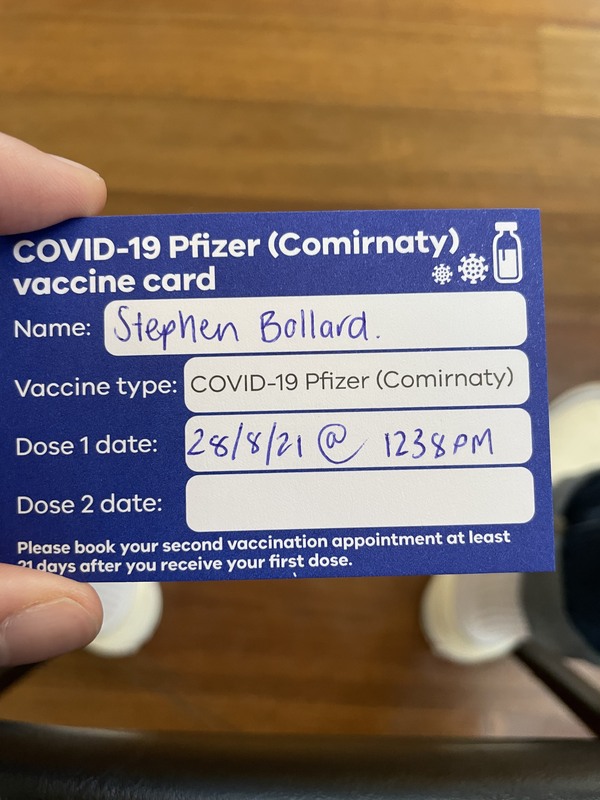 2021-08-28
2021-08-28The First Jab
HIST30060: This is an image of when I was waiting to leave the Royal Exhibition Building following my first vaccination. The experience was not something I was unfamiliar with, throughout high school I received regular vaccinations, the only downside this time was there not being a bowl of lollies to reward myself with as there was during high school. I had been anticipating the worst of symptoms after what I had heard from others, but fortunately all I really got was a stiff arm. This was also amidst the beginnings of the anti-vax movement and protests that we unfortunately are so accustomed to at this point. -
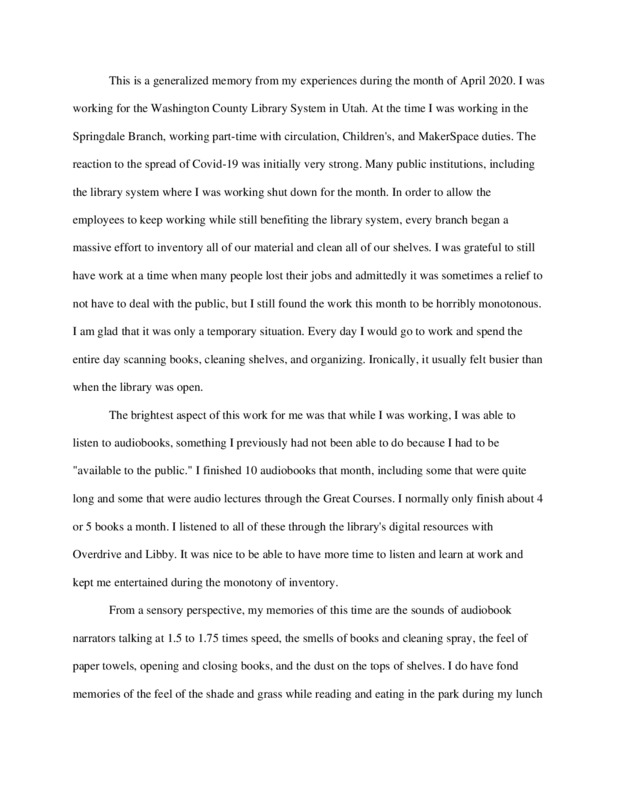 2020-04
2020-04Sudden Change to the Nature of Library Work
This story shows how pandemic radically changed workplace experience, including sensory memories, for my occupation as a library worker in Washington County Utah in April 2020. -
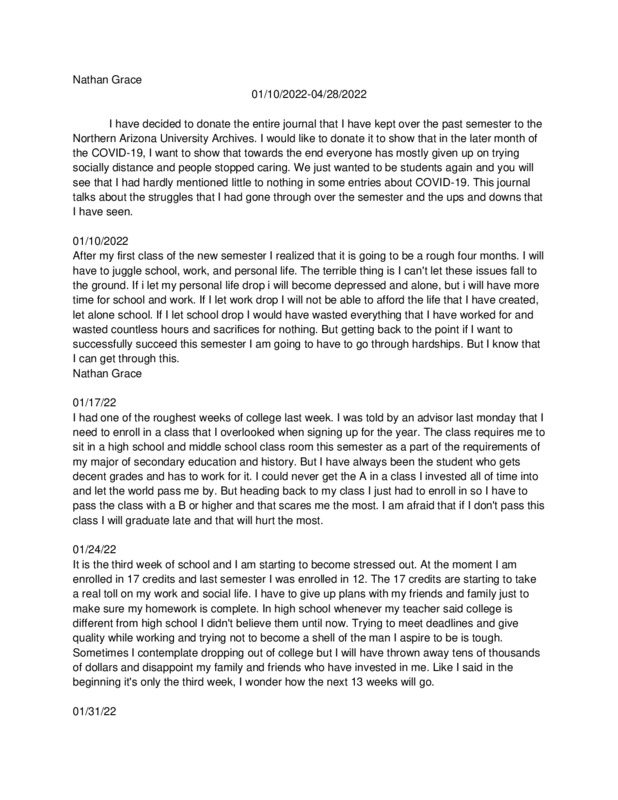 2022-01-10
2022-01-10life at NAU during 2022
in this journal I have mentioned many times how COVID really never effected me or the work that I had to do. -
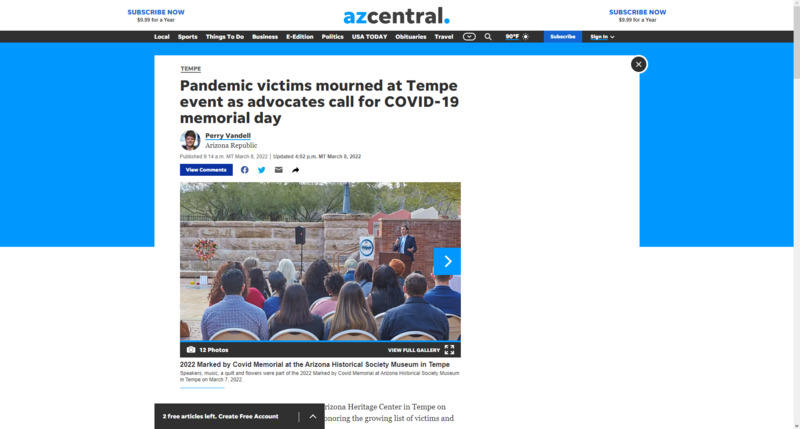 2022-03-08
2022-03-08Pandemic victims mourned at Tempe event as advocates call for COVID-19 memorial day
This article is about the Covid Memorial event held at the Arizona Heritage Center in Tempe on March 7, 2022. The event was organized by the Arizona Historical Society, the nonprofit organization Marked By COVID and the COVID Memorial Quilt project. The Covid Memorial Quilt is on display until August, 2022 at the Arizona Heritage Center. -
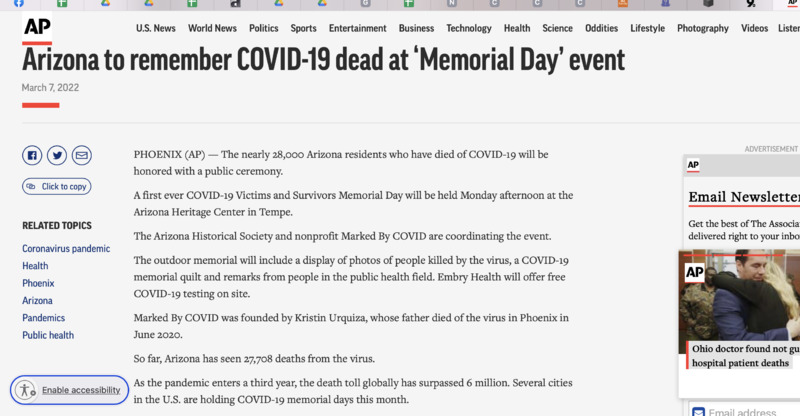 2022-03-07
2022-03-07Arizona to remember Covid-19 Dead at "Memorial Day" event.
This article is about the Covid Memorial Quilt exhibit at the Arizona Heritage Center in Tempe. The Arizona Heritage Center is a museum of the Arizona Historical Society. This article describes the quilt and the memorial event held on Monday, March 7, 2022. The event was sponsored in part by the non-profit group Marked by Covid which honors those who have died of Covid 19. Almost 28,000 Arizonans have died of Covid as of March 7th. -
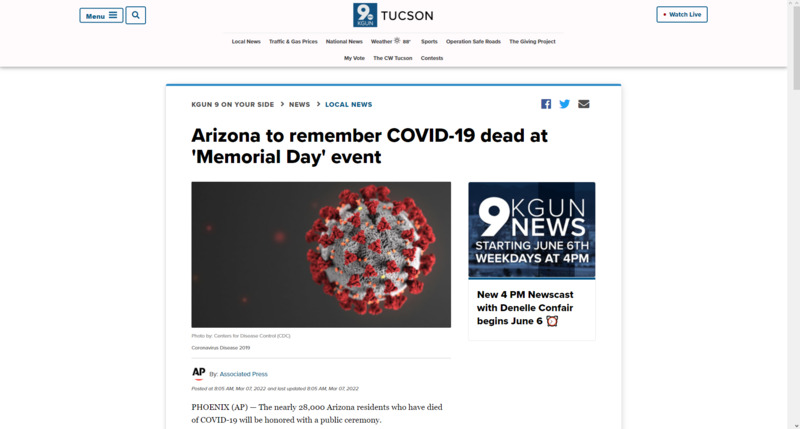 2022-03-07
2022-03-07Arizona to remember COVID-19 dead at 'Memorial Day' event,
This article is about the Covid Memorial Quilt exhibit at the Arizona Heritage Center in Tempe. The Arizona Heritage Center is a museum of the Arizona Historical Society. This article describes the quilt and the memorial event held on Monday, March 7, 2022. The event was sponsored in part by the non-profit group Marked by Covid which honors those who have died of Covid 19. Almost 28,000 Arizonans have died of Covid as of March 7th. -
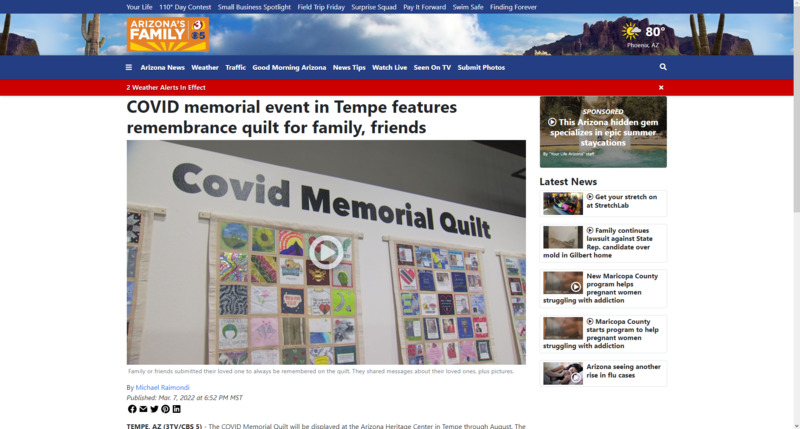 2022-03-07
2022-03-07COVID memorial event in Tempe features remembrance quilt for family, friends. AZ Family article
This article is about the Covid Memorial Quilt exhibit at the Arizona Heritage Center in Tempe. The Arizona Heritage Center is a museum of the Arizona Historical Society. This article describes the quilt and the memorial event held on Monday, March 7, 2022. -
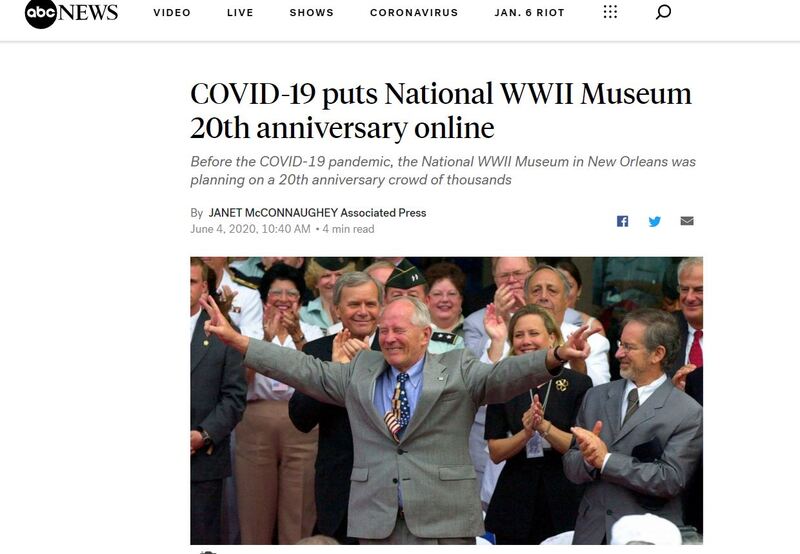 2020-06-04
2020-06-04COVID-19 puts National WWII Museum 20th anniversary online
This article details the holding of the 20th anniversary of the opening of the National WWII Museum in New Orleans on June 4th 2020. This is significant because thousands of people were supposed to attend, but now had to watch the ceremonies online as a result of the spread of COVID-19. This is an interesting contribution to the museum collection of the archive not only because the size of this event, but due to the fact that there are few military history museums mentioned in the archives. This is important to me as someone who studies military history, and because I was one of the many people spectating this ceremony online. -
 2022-01-19
2022-01-19National Postal Museum closes due to COVID-19
This article discusses the closure of the Smithsonian National Postal Museum in Washington D.C in January of 2022. This is significant due to the fact that its closure is a result of staffing shortages, which have been affecting museums all over the country during the COVID-19 pandemic. This is a significant contribution to the archives because museums do not have a lot of representation within the archives, especially postal museums. The article is important to me personally because I was able to visit there once while I was in Washington D.C., and it was an interesting experience. -
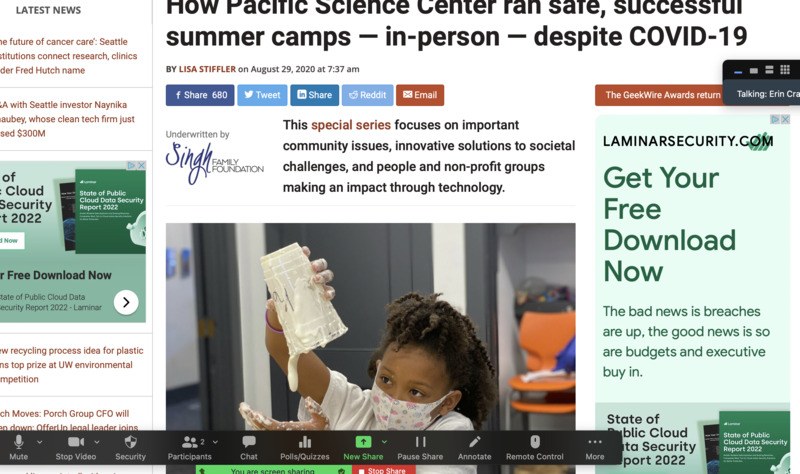 2020-08-29
2020-08-29Socially distanced and socially safe summer camp
The attached article is something that is probably not well known. In Seattle, Washington there is the Pacific Science Museum, a fun educational museum for all ages, but focused on kids. Every summer they run educational camps for K-8 graders. It was unclear if after months of distance learning (early pandemic, 2020) students would be physically or emotionally ready to do a group activity in person. PacSci’s camps were able to run while students were socially distanced and masked. This matters because there has been a lot of rhetoric about kids not being able to wear masks for a variety of reasons, but this article proves that kids were able to understand social distancing and mask-wearing so they could have a safe and fun thing to do. With these practices in place, combined with low group sizes, and the use of a lot of outdoor time, they didn’t have any transmission cases for the whole summer. Not included in the article but they had the same success the next summer, 2021, and are on track to continue again the summer of 2022. The significance is not just to a collection focused on children, but also to the service industry since this is a less formal education setting that leans more toward front-facing customer service. -
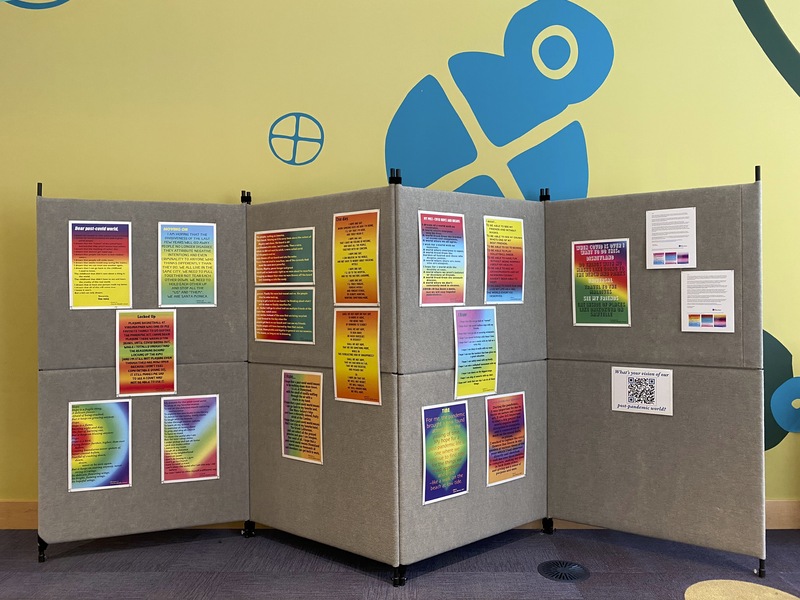 0002-03-01
0002-03-01SMhopes at the SMPL Teen Lounge
A variety of submissions to the SMhopes website, designed as posters and banners by Paula Goldman, and installed in the Teen Lounge at the main branch of the Santa Monica Public Library. The Library asked for a variety of hopeful messages as they begin having students visit the Teen Lounge again. -
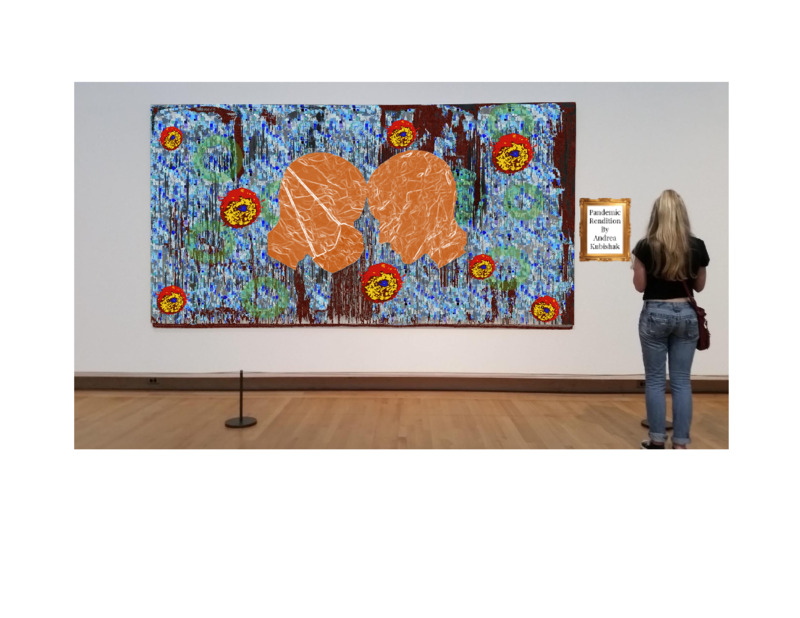 2022-02-25
2022-02-25Pandemic Rendition
The pattern of small, blue, unorganized, squares reminded me of a hospital or a doctor’s office, the first place I would go when I am sick. During this time, it seemed as if everyone was sick, there were no appointments available to meet with a doctor nor beds for individuals who were experiencing peak Covid symptoms. Words that describe a hospital: white walls, clean floors, sterile rooms, and order, or at least it was before the pandemic. The background is far from orderly, red is also present amongst the blue squares. This is to represent our health care professionals doing their best with the knowledge we had about this novel virus, but still witnessing many deaths. There are also green rings hovering around the two individuals. Green is often connected with germs or sickness. In the beginning cleaning products were flying off the shelves, people wanted to clean all surfaces as a preventative measure. This meant that consumers were buying several jugs of bleach, rubbing alcohol, hand sanitizer, disinfectant wipes, and many other products in surplus (creating many shortages). The air around the two individuals is filled with images of the Covid-19 virus under a microscope. Masks became a way to protect oneself from catching the virus, ultimately leading to mask mandates. The two individuals facing one another represent the mass separation we experienced during lockdown and with social distancing. -
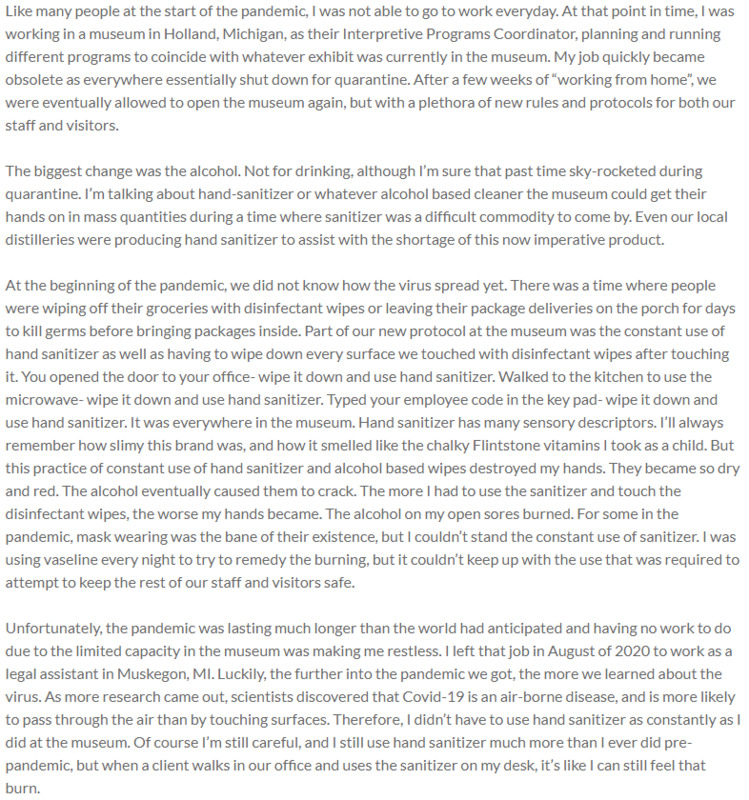 2020-06
2020-06Feeling the Burn
Like many people at the start of the pandemic, I was not able to go to work everyday. At that point in time, I was working in a museum in Holland, Michigan, as their Interpretive Programs Coordinator, planning and running different programs to coincide with whatever exhibit was currently in the museum. My job quickly became obsolete as everywhere essentially shut down for quarantine. After a few weeks of “working from home”, we were eventually allowed to open the museum again, but with a plethora of new rules and protocols for both our staff and visitors. The biggest change was the alcohol. Not for drinking, although I’m sure that past time sky-rocketed during quarantine. I’m talking about hand-sanitizer or whatever alcohol based cleaner the museum could get their hands on in mass quantities during a time where sanitizer was a difficult commodity to come by. Even our local distilleries were producing hand sanitizer to assist with the shortage of this now imperative product. At the beginning of the pandemic, we did not know how the virus spread yet. There was a time where people were wiping off their groceries with disinfectant wipes or leaving their package deliveries on the porch for days to kill germs before bringing packages inside. Part of our new protocol at the museum was the constant use of hand sanitizer as well as having to wipe down every surface we touched with disinfectant wipes after touching it. You opened the door to your office- wipe it down and use hand sanitizer. Walked to the kitchen to use the microwave- wipe it down and use hand sanitizer. Typed your employee code in the key pad- wipe it down and use hand sanitizer. It was everywhere in the museum. Hand sanitizer has many sensory descriptors. I’ll always remember how slimy this brand was, and how it smelled like the chalky Flintstone vitamins I took as a child. But this practice of constant use of hand sanitizer and alcohol based wipes destroyed my hands. They became so dry and red. The alcohol eventually caused them to crack. The more I had to use the sanitizer and touch the disinfectant wipes, the worse my hands became. The alcohol on my open sores burned. For some in the pandemic, mask wearing was the bane of their existence, but I couldn’t stand the constant use of sanitizer. I was using vaseline every night to try to remedy the burning, but it couldn’t keep up with the use that was required to attempt to keep the rest of our staff and visitors safe. Unfortunately, the pandemic was lasting much longer than the world had anticipated and having no work to do due to the limited capacity in the museum was making me restless. I left that job in August of 2020 to work as a legal assistant in Muskegon, MI. Luckily, the further into the pandemic we got, the more we learned about the virus. As more research came out, scientists discovered that Covid-19 is an air-borne disease, and is more likely to pass through the air than by touching surfaces. Therefore, I didn’t have to use hand sanitizer as constantly as I did at the museum. Of course I’m still careful, and I still use hand sanitizer much more than I ever did pre-pandemic, but when a client walks in our office and uses the sanitizer on my desk, it’s like I can still feel that burn. -
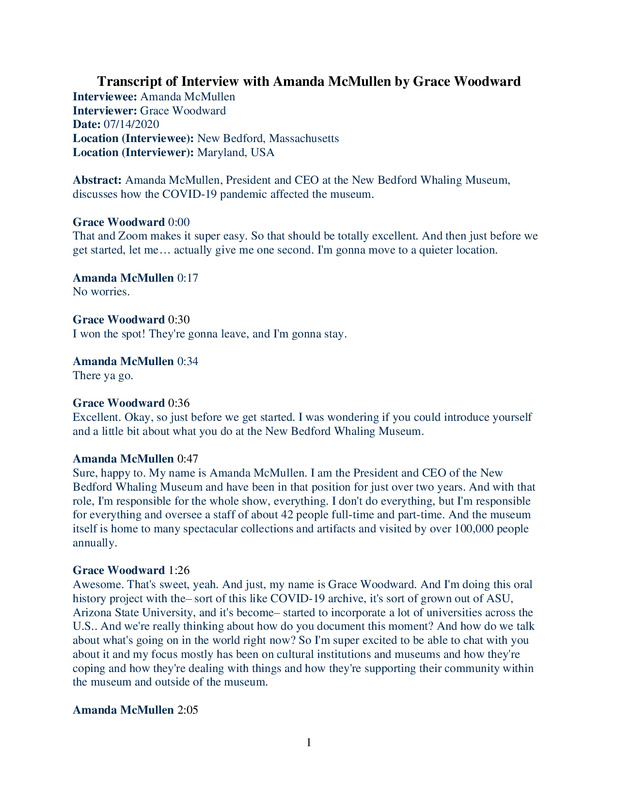 07/14/2020
07/14/2020Amanda McMullen Oral History, 2020/07/14
C19OH -
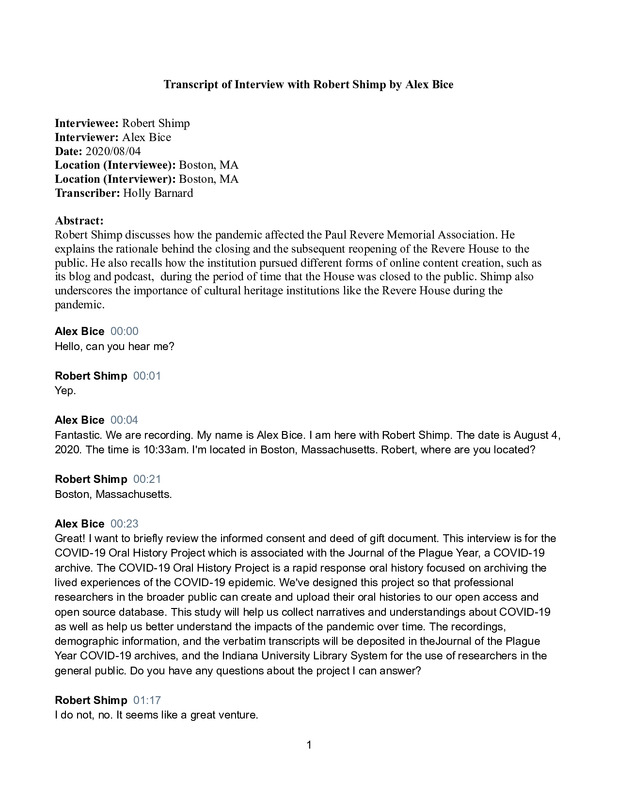 08/14/2020
08/14/2020Robert Shimp Oral History, 2020/08/04
In this interview, Robert Shimp discusses how the pandemic has affected the Paul Revere Memorial Association -
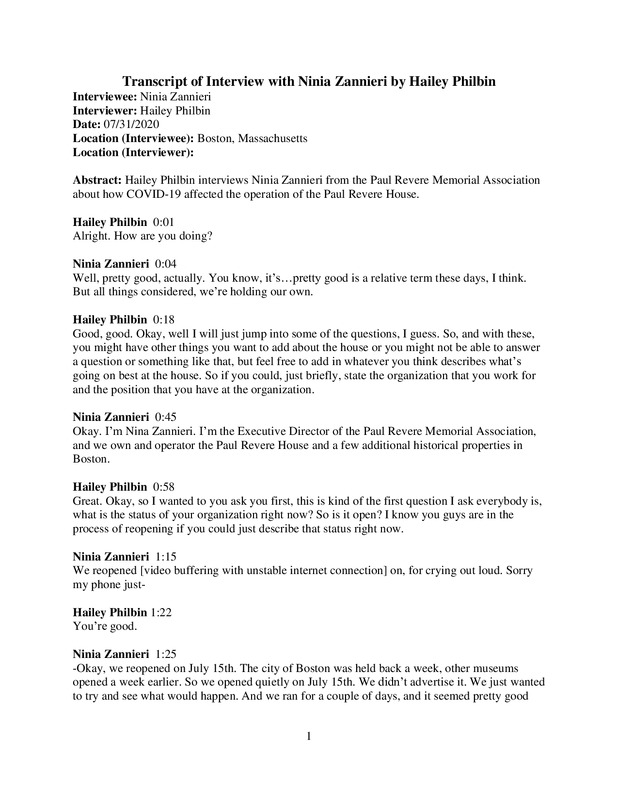 08/17/2020
08/17/2020Ninia Zannieri Oral History, 2020/07/31
C19OH -
 08/17/2020
08/17/2020Carol Knauff and Catherine Allgor Oral History, 2020/07/31
-
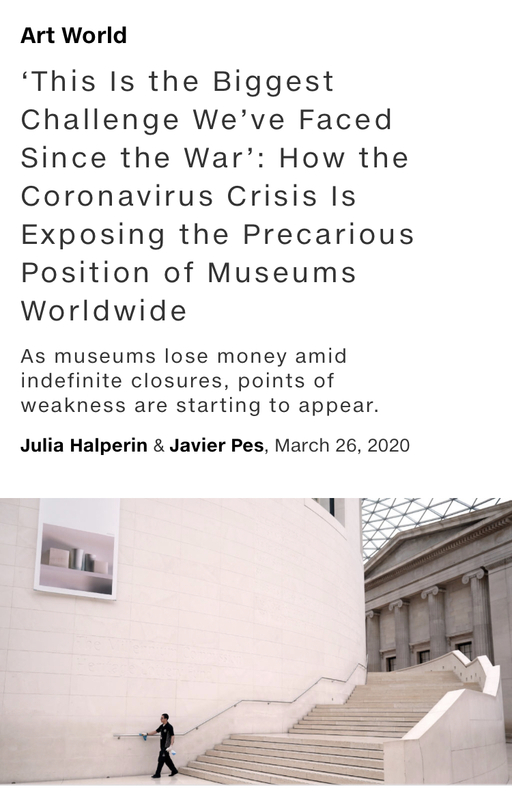 2020-03-26
2020-03-26‘This Is the Biggest Challenge We’ve Faced Since the War’: How the Coronavirus Crisis Is Exposing the Precarious Position of Museums Worldwide
The article discusses the financial hit to museums caused by the pandemic and fear and anxiety over how long museums can sustain amid a global shutdown. Whereas federal aid has come to the rescue of some museums provided by select countries for example, Germany and Britain; however, the United States does not have the same relief plans in place for cultural institutions. The pandemic has revealed weaknesses in the current museum model in relation to funding and what the article describes as a “winners take all mentality”. These problems have been compounding for decades but is the pandemic the straw that breaks the camel’s back? What might a new museum model look like if the old one is no longer sustainable? -
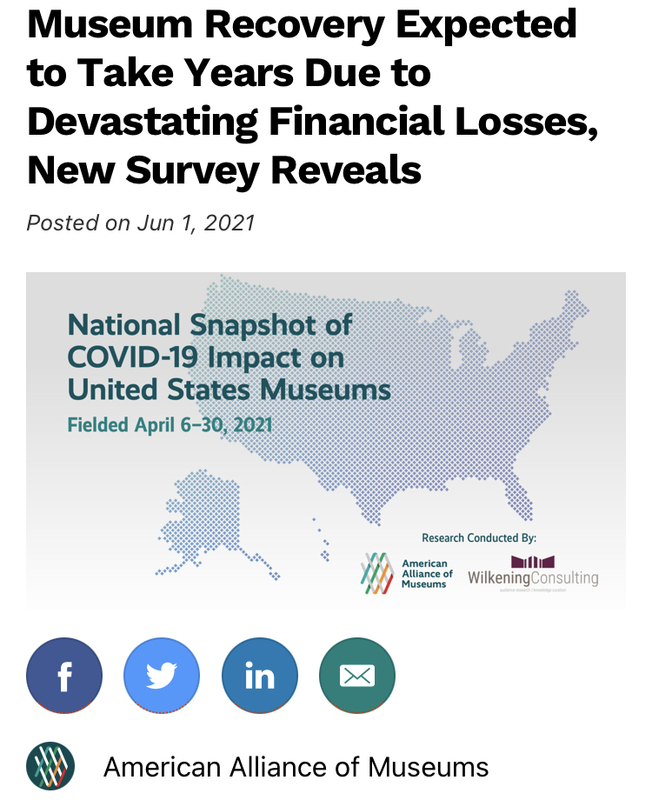 2021-06-01
2021-06-01Museum Recovery Expected to Take Years Due to Devastating Financial Losses, New Survey Reveals
The American Alliance of Museums report highlights financial problems and some of the more negative long-term impacts resulting from COVID-19 such as reduced overall net revenue for the institution, lower employment numbers, and lower average salary for their staff members. -
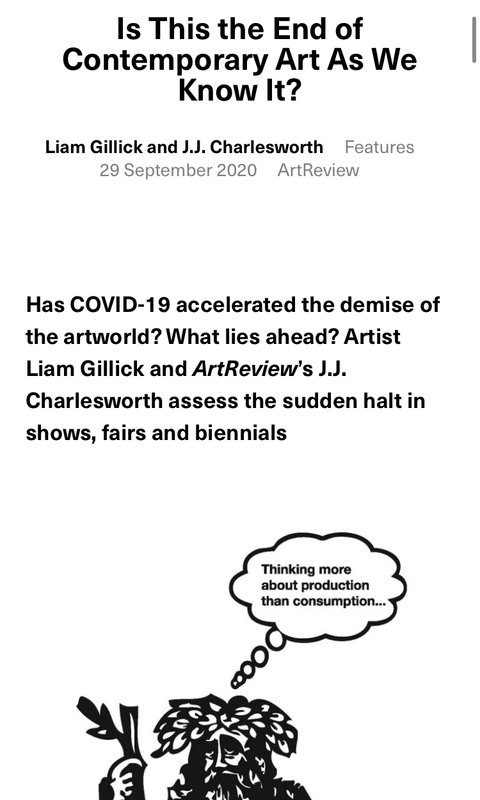 2020-09-29
2020-09-29Is This the End of Contemporary Art As We Know It?
Artist Liam Gillick and a writer for ArtReview, J.J. Charlesworth talk about the changes brought by the pandemic and the many ways that everything will most likely remain the same. Interestingly, they examine the beginning and end of “contemporary art” and the complex web of economic, social, political and cultural factors that are shifting and breaking down in different ways from our current crises. In the end, the feeling that art will survive but the idea that this particular period of art and the art world has reached its end is contemplated. -
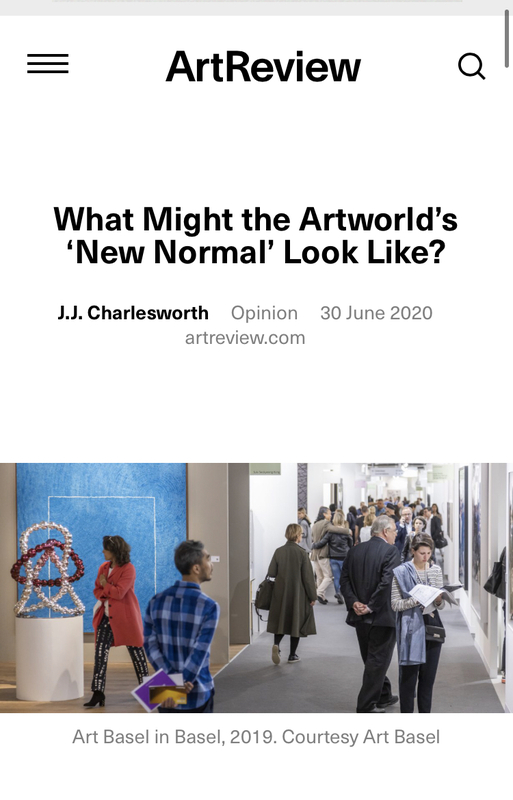 2020-06-30
2020-06-30What Might the Artworld’s ‘New Normal’ Look Like?
The ArtReview article comments on the new normal and the possible dangerous path we are propelling towards as a society with accelerated speed. The article specifically discusses the use and imminent fears on future reliance of technology in the art sector. Looking on the positive side, social justice and pressure from activism groups and the Black Lives Matter movement have spurred the beginning of greater reform within the art world including decolonization efforts in museums, diversity in collections, exhibitions, and staff. -
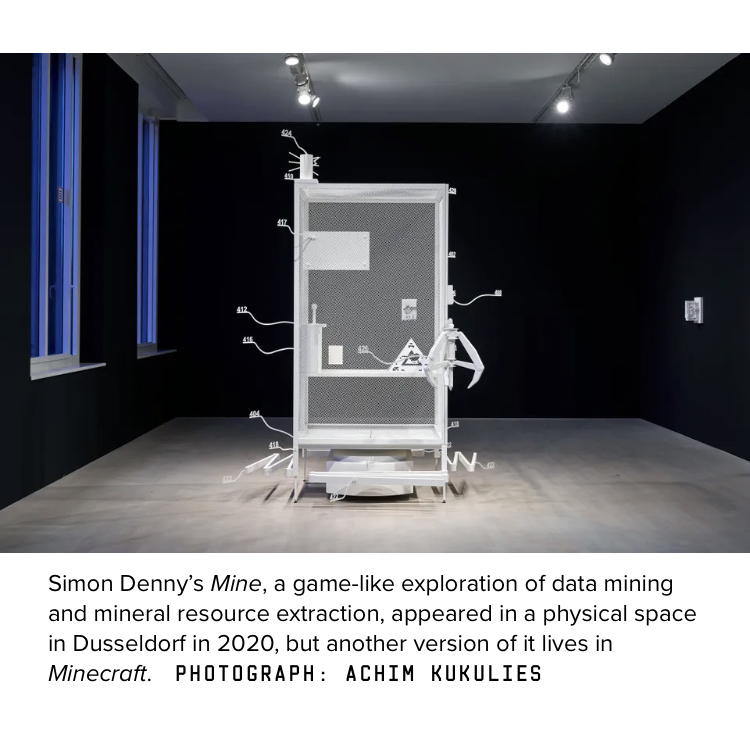 2021-02-09
2021-02-09Artists Reimagine How Covid-19 Will Shape the Art World
This Wired piece by Lydia Horne starts off with a really interesting point about the viewer relationship with art as social distancing before Covid and the distance in museums and galleries for the artwork’s protection. It is more than just considerations about virtual auctions and virtual viewing - the way that the art itself translates is something that many artists are struggling with. The article also speaks to the ways that artists are redefining themselves and their work. The changing structures and changing methods reaching an audience or sharing work, some artists are using the pandemic to explore possibilities to reshape the art world. For example, non-profits and community-based models instead of the traditional gallery model. -
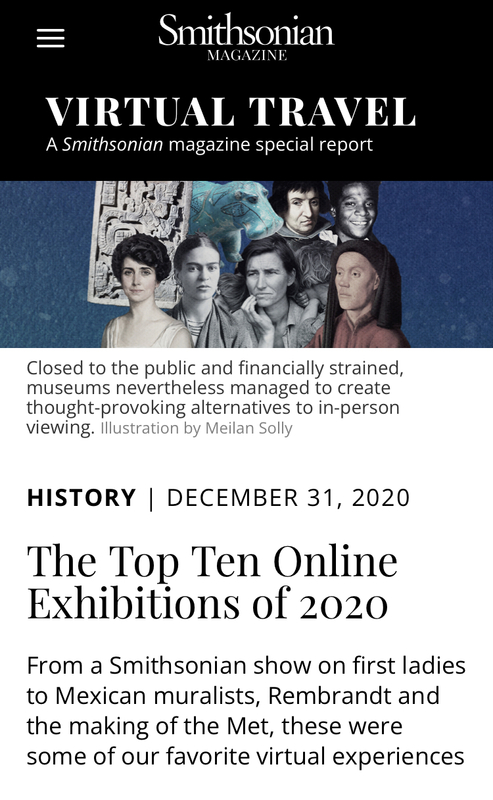 2020-12-31
2020-12-31The Top Ten Online Exhibitions of 2020
In an end of the year article, Smithsonian lists the top ten virtual museum exhibitions of 2020: 1. The Smithsonian’s National Picture Gallery, “Every Eye Is Upon Me: First Ladies of the United States” 2. Peabody Essex Museum, “Jacob Lawrence: The American Struggle” 3. The Whitney Museum, “Vida Americana: Mexican Muralists Remake American Art, 1925-1945” 4. The Museum of Modern Art, “Dorothea Lange: Words & Pictures” 5. Museum of Fine Arts, Boston, “Writing the Future: Basquiat and the Hip-Hop Generation” 6. Metropolitan Museum of Art, “Making the MET, 1870-2020” 7. The British Museum, “The Museum of the World” 8. The Rijksmuseum, “The Night Watch” 9. Museum of Fine Arts, Ghent, “Van Eyck an Optical Revolution” 10. Instituto Cervantes, “Wise and Valiant: Women and Writing in Gold Age of Spain” -
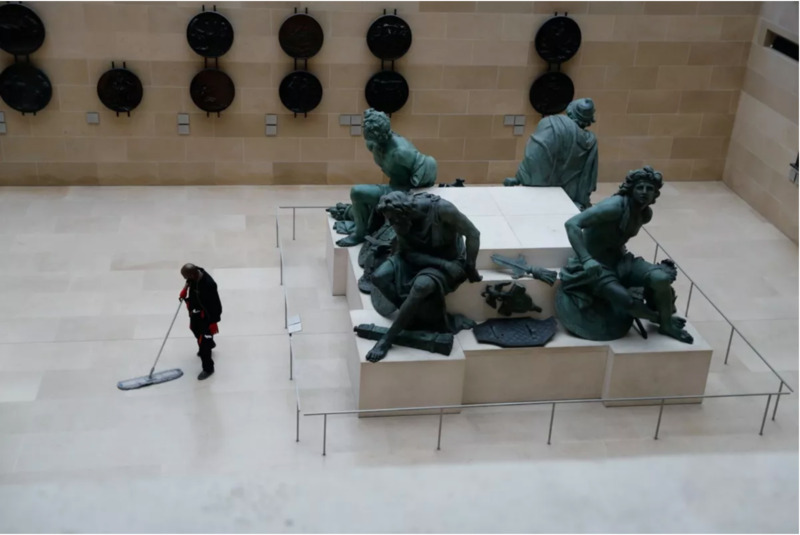 2020-03
2020-03Image from Inside a Closed Museum During Lockdown, Musée du Louvre
This is an image included in the article, "Museums, Curators, and Artists Find Innovative Solutions for Showing Art in a Pandemic". Taken from a bird's eye view from within the Musée du Louvre, the image shows an empty museum gallery save for a solitary employee. The image is captioned "An employee walks next to Martin Desjardins’s Quatre Captifs in the Musee du Louvre, Paris, closed to the public indefinitely amid concerns on the COVID-19 outbreak, 2020. " -
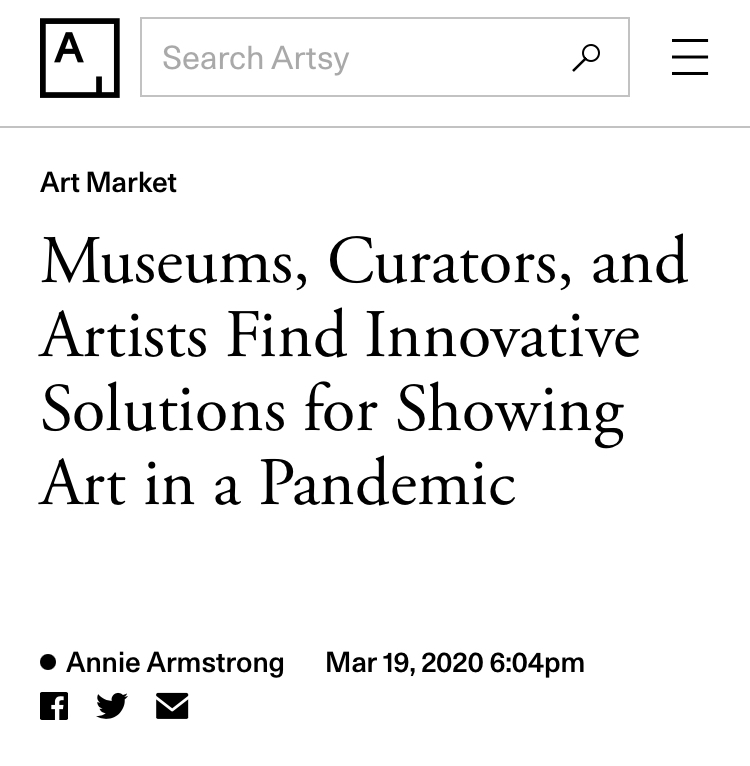 2020-03-19
2020-03-19Museums, Curators, and Artists Find Innovative Solutions for Showing Art in a Pandemic
This Artsy article written in the beginning of the pandemic discusses the innovative ways that museums and art professionals used technology to maintain relevance and viewership during lockdown. -
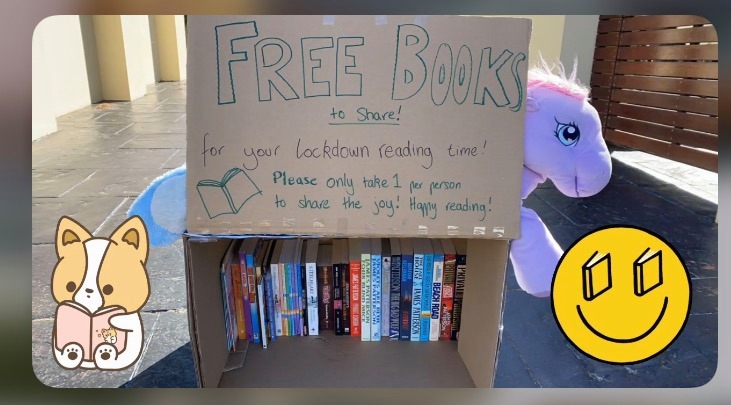 2021-08-10
2021-08-10Lockdown Library - HIST30060
During the 6th Victorian lockdown in August 2021, my family decided to do some cleaning of our old children’s books to pass the time. My mum decided to set up this little ‘lockdown library’ to give the books out for free to good homes, in hopes of helping kids who are stuck at home stay busy during the lockdown and online schooling. As they cleaned, they also found some adult books to give away as well, in hopes that it would help provide not only entertainment, but a reminder of human kindness and the fact that we are all in this together. -
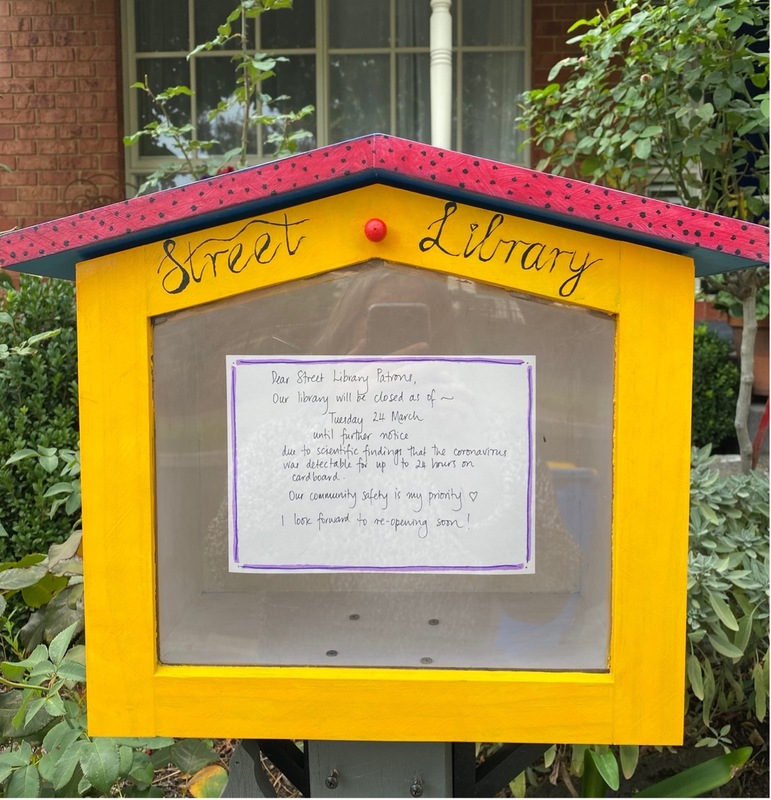 2020-03-24
2020-03-24Closing My Street Library (HIST30060)
(HIST30060) This is a photo of the closed sign my Mum and I put on our street library after we found out about the pandemic in 2020. It reads: Dear Street Library Patrons, Our library will be closed as of Tuesday 24 March until further notice due to scientific findings that the coronavirus was detected for up to 24 hours on cardboard. Our community safety is my priority <3 I look forward to re-opening soon! We made the street library in 2019 so the community could share our love of books. People could take a book, read it and, if they wanted to, put their favourite book back in. It made us sad to close the street library but after the lockdown was over we started it back up again! -
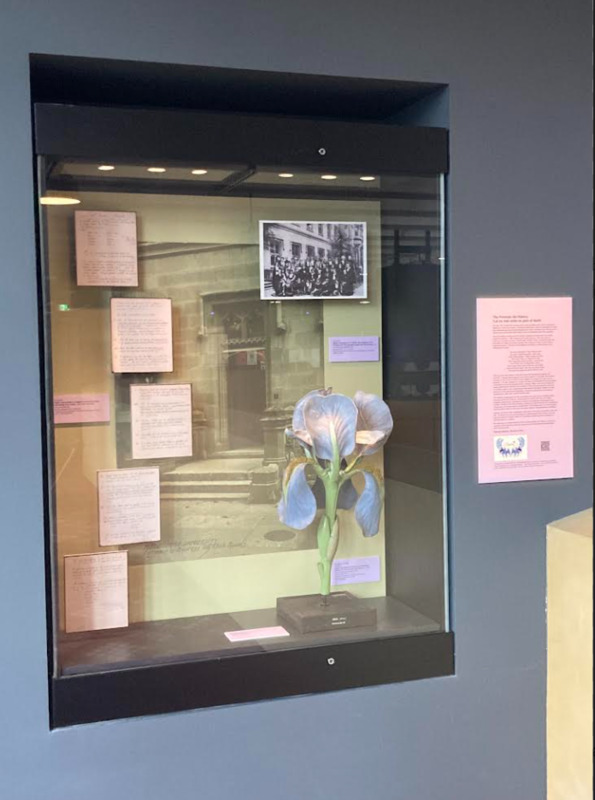 2021-07-29
2021-07-29(HIST30060) An Exhibition I Created at University
After a year as subeditor, I was lucky enough to be appointed the 2021 editor of Chariot, the undergraduate history journal at the University of Melbourne. As an initiative to raise student engagement and make history more interesting, I worked with the university staff and one of our previous contributors of the journal in turning her essay into an exhibition in the university's Arts West building. Unfortunately, due to the lockdown, I was unable to see the exhibition in person myself, but the experience of putting it together from start to finish was a hugely rewarding one. -
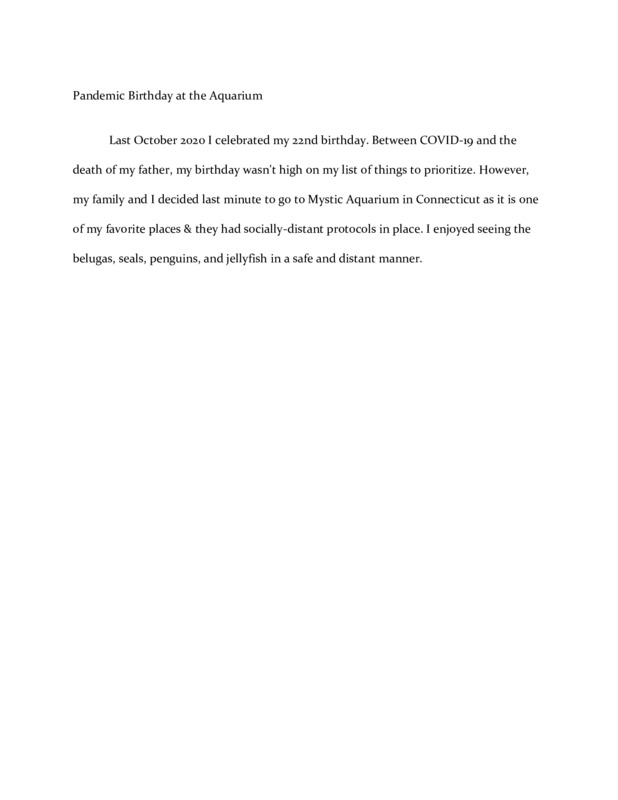 2020-10
2020-10Pandemic Birthday at the Aquarium
Last October 2020 I celebrated my 22nd birthday. Between COVID-19 and the death of my father, my birthday wasn't high on my list of things to prioritize. However, my family and I decided last minute to go to Mystic Aquarium in Connecticut as it is one of my favorite places & they had socially-distant protocols in place. I enjoyed seeing the belugas, seals, penguins, and jellyfish in a safe and distant manner. -
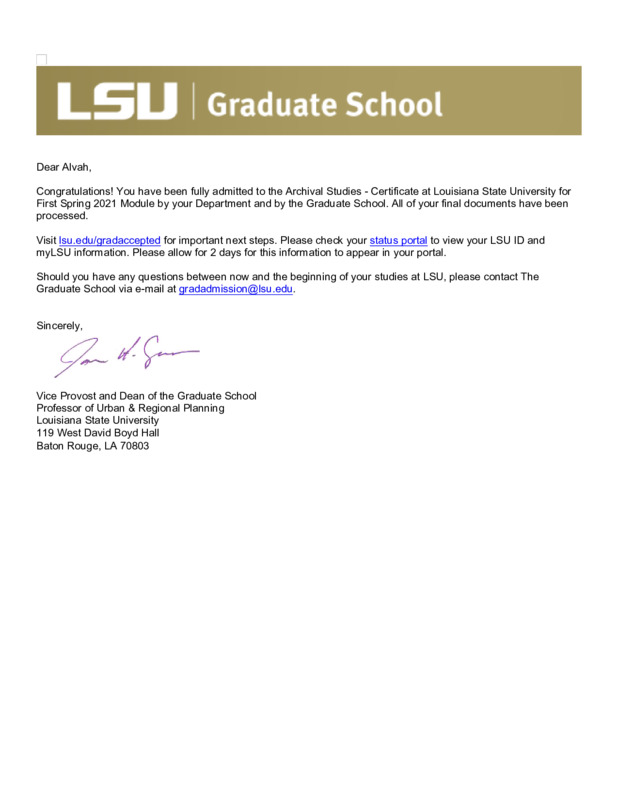 2020-12-07
2020-12-07Back to School
This year has been hard for a lot of people. Like many others during quarantine, I decided the jobs that I had were not right for me. Almost by chance, a friend of my wife's told her about this program for a Graduate Certificate in Archival Studies at LSUOnline. It was designed for people who already had a master's degree, but were looking to get into the archival field or further their specialization. It seemed like a good fit for me. I have an MA in history and experience working in archives, so with everything shut down it seemed like the right time to do it. It has been tough, but I'm nearing the end of the program. One of the hardest parts for me has been that I have not been able to be as excited as I normally would be about this. I am experiencing a great deal of burnout with work, the program, and various COVID related things, but overall, I have been fortunate through this whole pandemic, and me finishing this program is proof of it. But so many people close to me are front line workers who are mentally struggling to get by from day to day. It is hard for me to post updates on my COVID success story on my social media, when my closest friends are burnt out and were not in as fortunate a position as I have been. For me, it has been hard to celebrate my triumphs when I see some of my closest friends reaching their breaking points and feel completely helpless. -
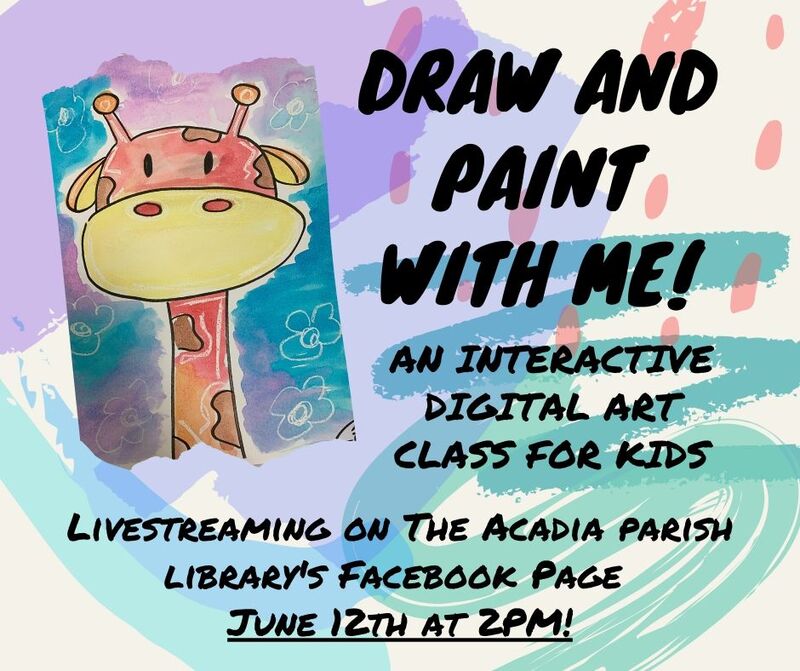 2020-12-31
2020-12-31The Summer Your Librarians Became Youtubers...
I am a children's librarian in rural Louisiana. We are approximately two hours away from all major forms of entertainment, so the library acts as not only a community hub but a place for children to learn and participate in extracurricular activities year-round... until Covid. Though our community hardly noticed the virus itself, the effects of being locked down soon took hold, and we were left with a community of children, families, and elderly people more isolated than they usually were. The depression set in. And my director had the fabulous notion to take what we did to the airwaves... Or rather the internet. Our seriously underutilized Facebook Page became the hub of activity, and overnight we went from librarians to Youtubers leading digital craft and art classes, Zoom creative writing workshops, and nightly bedtime stories. What initially began as a means to cheer up the children soon developed into full-fledged outreach. Local politicians, law-enforcement, and other community leaders read stories for us on our page as a means to connect with the people in our community. We did special digital story hours with schools once they opened back up in the fall, and also read stories to patients in the nursing home. Continuing with this train of thought, we partnered with our local American Legion Hall, which is located on a main thoroughfare and has large windows clearly visible from the road, to set up our annual "Christmas Around the World" exhibit (which features Christmas traditions from many different countries as well as Kwanzaa and Hanukah traditions) since there was no way to feature the display in our small meeting room safely. Every program was modified, digitized, and brought to the people of our community in the best possible way they could be... which turned the 'year of the plague' into a year of learning, cooperation, and ingenuity for us. -
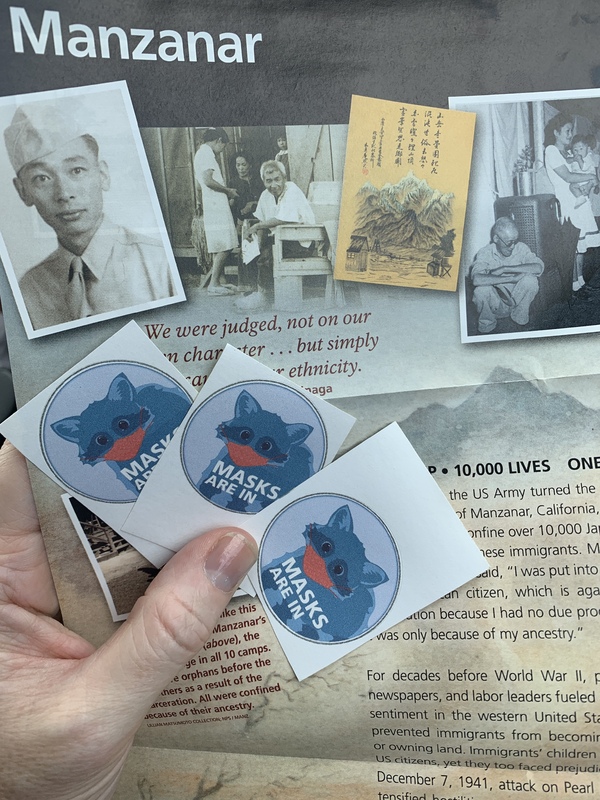 2021-07-10
2021-07-10Manzanar
As a historian, US History teacher, and mother of two Asian-American children, I make a point to expose my children to all aspects of America’s history: good, bad, and ugly. Thanks to COVID, we had the opportunity to show the kids one of the country’s ugliest moments - Japanese internment. The desolate desert in the middle of our home state is an area I had never driven through before COVID, despite having lived in CA my entire life and being (supposedly) 8th or 9th generation Californian on my dad’s side. However, there is no way I’m putting my family on an airplane during a pandemic, which limits vacation options. So into the car for an eight hour drive to Tahoe. A drive that goes right past Manzanar, the Japanese American World War II concentration camp. Unlike last year, when we made the same drive for the first time in my life, the exhibits, buildings, and visitor center were open with masks and social distancing. As we stood in the barrack in the 106 degree temperature, I told my kids to never forget how uncomfortable they felt and to consider the fact that they were feeling awful from the heat as tourists. I told them to imagine living in this heat as a prisoner though you committed no crime except having ancestors from Japan. They may be young, but they are old enough to understand human rights. Visiting Manzanar was overwhelming. I am not a very emotional person, but I was taken aback by the fact that this history is so recent. My best friend’s dad was born in Tule Lake, where Japanese-Americans who refused to take the forced loyalty oath were sent. That is only one generation before mine. Seeing and experiencing second hand through family and friends the hatred directed toward Asian-Americans during this pandemic made the experience in Manzanar extra raw. Though I refuse to thank COVID for anything because I think that’s a bit tone deaf for all who have lost and suffered during this pandemic, I am grateful that the circumstances that led us to drive to Tahoe instead of fly led us also to a place of reflection on prejudice and race, especially in the climate of today. -
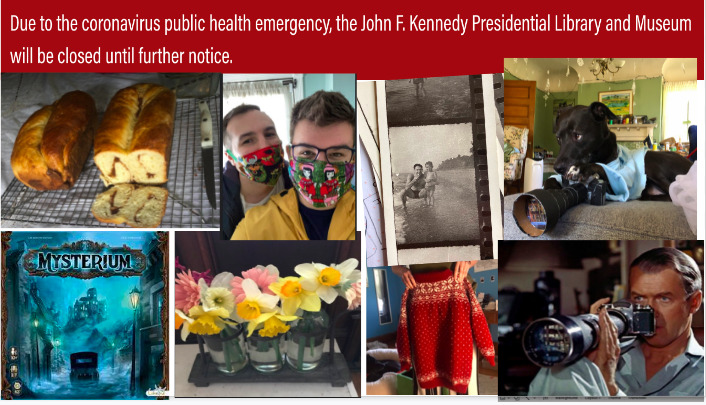 2021-05-09
2021-05-09Boston Lockdown
The JFK Library and Museum closed during the shutdown and I lost the best job I ever had. I graduated Boston University without a ceremony. I spent my first year in grad school on zoom. I ended up living with my 2 adult siblings and my parents who were either working virtually or not at all. I decided that I would take the time at home to learn things that I had always intended to, mostly because I didn't want to lose my mind. I baked bread, lots of bread: challah, bagels, cinnamon rolls, babka and more. I knit a complicated sweater. I sewed masks for my friends and I played games with my family. I research and organized 7 generations of my family's pictures, documents, videos and newspaper clippings. I started growing vegetables and flowers and I watched hundreds of English Premier Soccer games. The most fun I had was hanging out with my dog. For Halloween I made he and I costumes from the movie Rear Window. I feel like I did my best to survive the Plague, I am proud of all I was able to accomplish and I have more good memories than I thought was possible. I appreciate the normal things I took for granted pre-pandemic and I look forward to the end. -
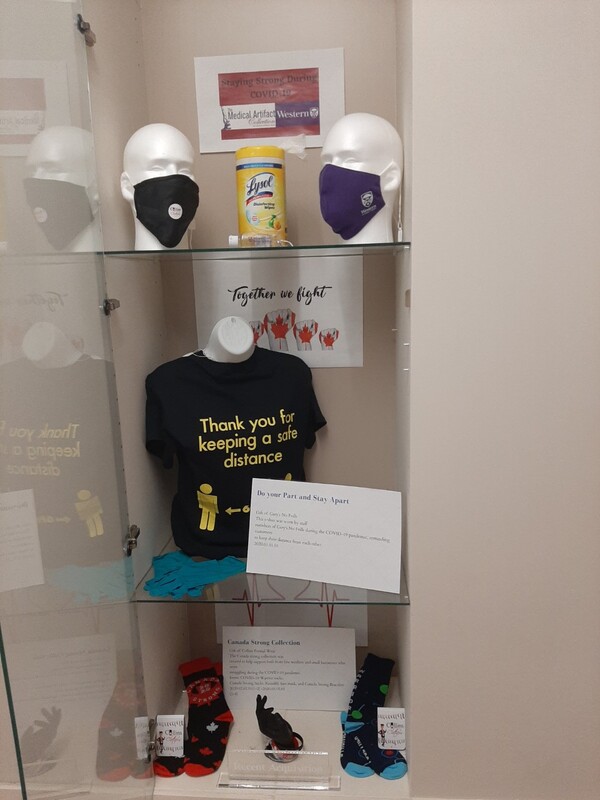 2020-09-30
2020-09-30"Staying Strong During COVID-19" New Acquisitions Exhibit
This exhibit was installed by the Medical Artifact Collection at Western University. It features several COVID-19 related artifacts that were recently donated to the collection in 2020. The exhibit was curated and installed by the collection's research assistant Kat Bezaire. -
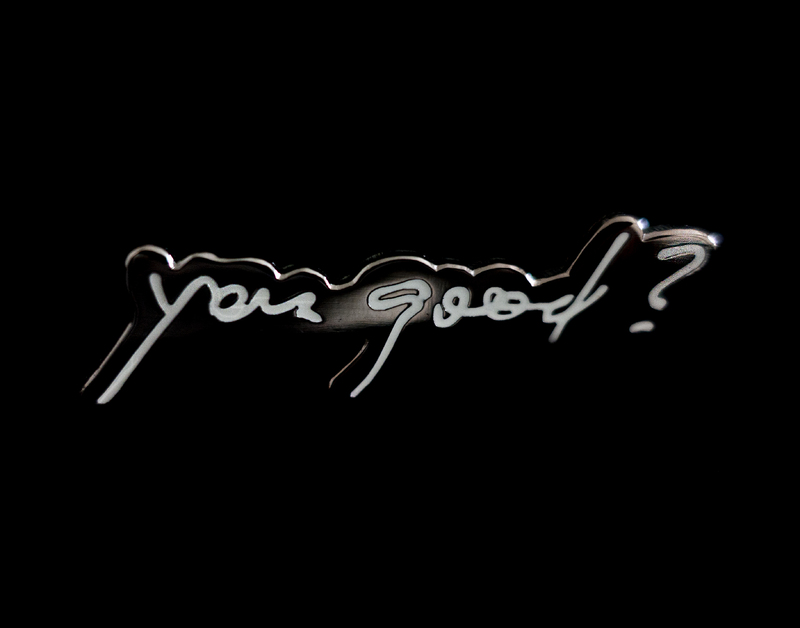 2021-01-22
2021-01-22you good?
At the beginning of the shut down, I got an email from a friend who asked "you good?". I didn't know how to answer that; I wondered if anyone was "good". Over the next few months I worked on a photographic piece for a show at the Museum of Art and History in Lancaster that opened in January. I had a neon sign made for the title. The museum then had glowin the dark pins made to sell in their store. It seemed to hit a nerve because it sold out in few weeks and they have to reorder. I have a fantasy of everyone walking around with these pins: you good? -
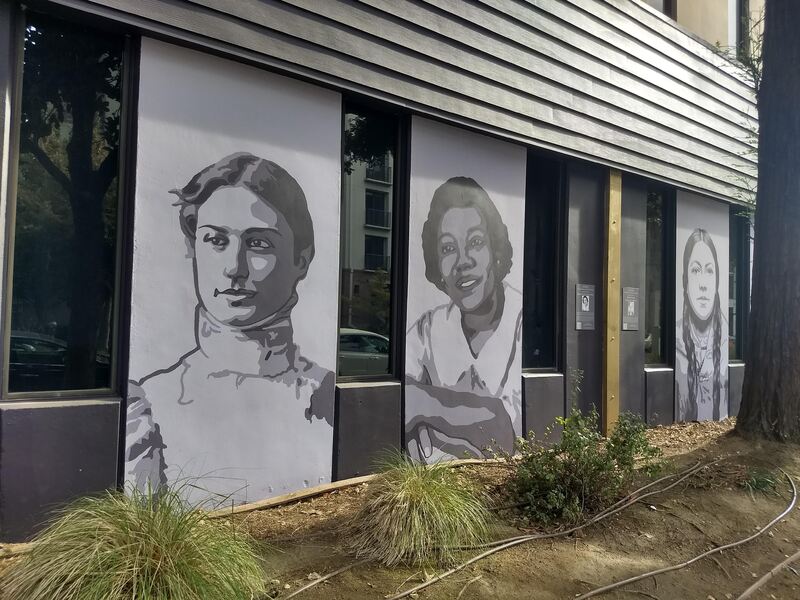 2020-11-11
2020-11-11Pandemic Street Art: I VOTE
On November 11, 2020, my middle child and I went for an art walk in midtown Sacramento to celebrate her birthday. Amongst the murals, many of which were put up during Wide Open Walls events of the past few years, we came across a new collection on the WEAVE building. The mural collection commemorates 100 years of the 19th amendment. WEAVE (Women Escaping a Violent Environment) is "the primary provider of crisis intervention services for survivors of domestic violence and sexual assault in Sacramento County." The artist of these murals is Maren Conrad, a Sacramento artist. She put these up during the pandemic, in October 2020. -
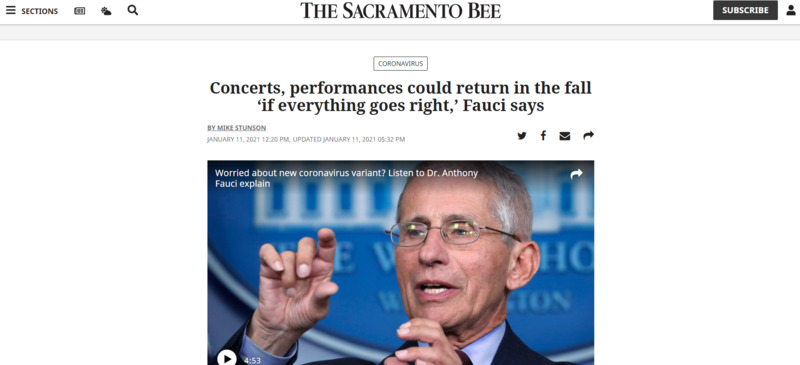 2021-01-11
2021-01-11Concerts, performances could return in the fall ‘if everything goes right,’ Fauci says
Dr. Anthony Fauci offered hope that concerts and theater performances could return in 2021. Speaking at a conference for the Association of Performing Arts Professionals, the nation’s top infectious disease expert was asked when indoor venues will be able to reopen their doors for the public. The performing arts industry has largely been shut down during the COVID-19 pandemic. Fauci said it’s important for the country to reach herd immunity of 70 to 85% of the population vaccinated from the coronavirus. -
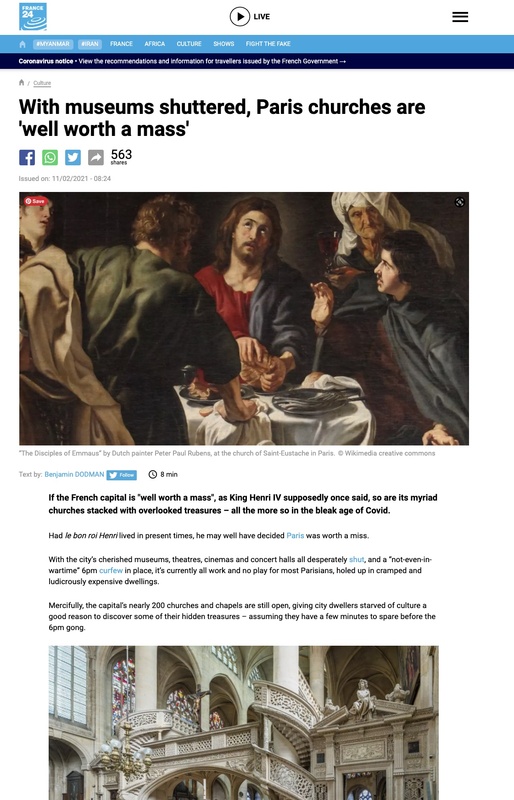 2021-02-02
2021-02-02With museums shuttered, Paris churches are 'well worth a mass'
As France has continued to deal with lockdowns, one bright spot for the French people is that most of the churches remain open. These churches are serving, for many, as a source of art and culture as museums and theaters have remained closed. Despite the fact that many of the Catholic churches in France are missing some of their most historic items, the interest in the art and architecture of the cathedrals has been renewed during the pandemic. -
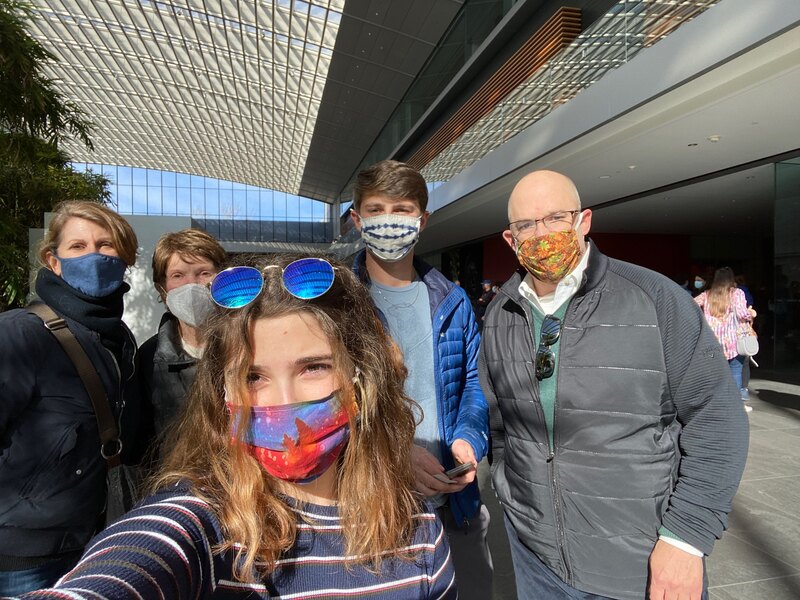 2021-03-13
2021-03-13Mask On F*** it, Mask Still on
There's not much to tell, everyone in this photo (besides my brother, in the white a blue mask) already had COVID but we still wore our masks knowing there's still the possibility of spreading the virus.
